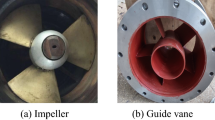This study continues our systematic exploration of the design of an axial circulatory assist blood pump with a rotor on magnetic bearings. The work reported here addresses experimental validation of a numerical model of flow in the flow part of the axial blood pump. The study focuses on design of the test rig, design of experiments, and modeling of blood flow in the flow part of the pump using computational fluid dynamics. The working fluid was distilled water. The flow-pressure characteristics obtained experimentally were compared with those from mathematical modeling. A satisfactory agreement between the results was obtained, such that the mathematical model can be used for future simulation of the operation of the pump and further optimization of the main components.
Similar content being viewed by others
References
Averbukh, V. M., “Sixth-generation technology and the prospects for Russia (a brief review),” Nauka Innov. Tekhnol., No. 71, 159-166 (2010).
Kirklin, J. K. et al., “Eighth annual INTERMACS report: Special focus on framing the impact of adverse events,” J. Heart Lung Transplant., 36, No. 10, 1080-1086 (2017).
Denisov, M. V. et al., “Development of medical and technical requirements and simulation of the flow–pressure characteristics of the Sputnik pediatric rotary blood pump,” Biomed. Eng., 50, No. 5, 296-299 (2017).
Got’e, S. V. et al., “First experience of the clinical use of the Russian circulatory assist device based on an implantable axial pump for a two-stage heart transplant,” Vestn. Transplantol. Iskusstv. Org., 15, No. 3, 92-101 (2014).
Itkin, G. P., Sysoev, A. A., and Zhdanov, A. V., “Development of an axial pump for two-stage heart transplantation in children,” Vestn. Transplantol. Iskusstv. Org., 17, No. 2, 85-89 (2015).
Telyshev, D. V., Denisov, M. V., and Selishchev, S. V., “The effect of rotor geometry on the H−Q curves of the Sputnik implantable pediatric rotary blood pump,” Biomed. Eng., 50, No. 6, 420-424 (2017).
Selishchev, S. V. and Telyshev, D. V., “Optimisation of the Sputnik-VAD design,” Int. J. Artif. Organs, 39, No. 8, 407-414 (2016).
Morozov, V. V., Zhdanov, A. V., and Belyaev, L. V., “Use of computer modeling in the development of a pediatric circulatory assist system,” Vestn. Transplantol. Iskusstv. Org., 18, 68-168 (2016).
Morozov, V. V. et al., An Implantable Circulatory Assist System Based on Mechanotronic Modules [in Russian], VGU, Vladimir (2006).
Gouskov, A. M. et al., “Assessment of hemolysis in a ventricular assist axial flow blood pump,” Biomed. Eng., 50, No. 4, 233-236 (2016).
Gouskov, A. M. et al., “Minimization of hemolysis and improvement of the hydrodynamic efficiency of a circulatory support pump by optimizing the pump flowpath,” Biomed. Eng., 51, No. 4, 229-233 (2017).
Versteeg, H. K. and Malalasekera, W., An Introduction to Computational Fluid Dynamics: The Finite Volume Method, Pearson Education (2007).
Su, B. et al., “Evaluation of the impeller shroud performance of an axial flow ventricular assist device using computational fluid dynamics,” Artif. Organs, 34, No. 9, 745-759 (2010).
Ansys CFX Solver Theory Guide, Ansys Inc., Canonsburg, PA (2011).
Throckmorton, A. L. et al., “Computational analysis of an axial flow pediatric ventricular assist device,” Artif. Organs, 28, No. 10, 881-891 (2004).
Apel, J., Neudel, F., and Reul, H., “Computational fluid dynamics and experimental validation of a microaxial blood pump,” ASAIO J., 47, No. 5, 552-558 (2001).
Wu, J. et al., “Computational fluid dynamics analysis of blade tip clearances on hemodynamic performance and blood damage in a centrifugal ventricular assist device,” Artif. Organs, 34, No. 5, 402-411 (2010).
Zhang, Y. et al., “Design optimization of an axial blood pump with computational fluid dynamics,” ASAIO J., 54, No. 2, 150-155 (2008).
Untaroiu, A. et al., “Computational design and experimental testing of a novel axial flow LVAD,” ASAIO J., 51, No. 6, 702-710 (2005).
Author information
Authors and Affiliations
Corresponding author
Additional information
Translated from Meditsinskaya Tekhnika, Vol. 53, No. 2, Mar.-0Apr., 2019, pp. 1-4.
Rights and permissions
About this article
Cite this article
Gouskov, A.M., Sorokin, F.D., Banin, E.P. et al. Experimental Validation of a Numerical Model of an Axial Circulatory Assist Blood Pump. Biomed Eng 53, 77–81 (2019). https://doi.org/10.1007/s10527-019-09881-5
Received:
Published:
Issue Date:
DOI: https://doi.org/10.1007/s10527-019-09881-5



